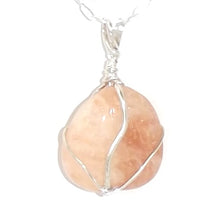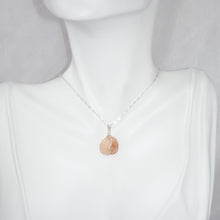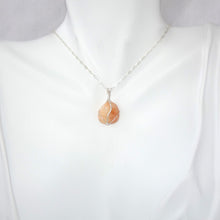
Naturally Ocean Tumbled Quartz from Cape May, New Jersey. This little peachy orange colored 'Cape May Diamond' is craftsman-wrapped in solid Argentium silver (.940) by our Florida West Artisans and is part of our Tide Collection of jewelry. Some history of Cape May 'Diamonds' (Natural Ocean Tumbled Quartz) is listed on the bottom of this page.
Quartz Size: 1/2"L x 1/2"W (15mm x 14mm)
Top to Bottom Pendant Length: 7/8"L (24mm)
Chain Included: 16" Sterling Silver (.925) chain. (If you would prefer a 15", or an 18" silver chain, please let us know at the time of placing your order.)
Argentium(r) is the the finest of sterling, alloyed with germanium, rather than copper. It is more pure than solid sterling silver which is .925 pure (925 parts out of 1000 parts pure silver) Argentium(r) is .940 pure silver (940 parts out of 1000 parts pure silver), and is more white and more tarnish resistant than standard sterling silver.
The History of Cape May Diamonds
Cape May Diamonds: by Karen Fox
“These beautiful gems we call Cape May diamonds are pure quartz crystals,” says Jeanette Bartolomeo. “They are, in fact, semi-precious stones with a hardness of seven compared to a genuine diamond’s hardness of 10.” Like real diamonds, they are hard enough to cut glass.
Cape May diamonds are our today-connection with the Ice Age. Thousands of years ago, giant sheets of ice covered much of the East Coast. As the glaciers melted, moving northward, they deposited quartz pieces, chipped and torn from the upper reaches of the Appalachian Mountains in northeastern Pennsylvania. The Delaware was a young river then, over the millennia growing into the powerful body of water it is now, traveling 200 miles from its head waters to Delaware Bay to its rendezvous with the Atlantic Ocean. The waters sweep along the quartz pieces, breaking, buffeting, polishing the stones as they roll toward the Atlantic. Some scientists say it takes a stone 3,000 years to make the journey. The river continuously dumps quantities of the pebbles at the mouth of the bay where strong winds whip waves, tossing the stones onto the beaches. The decaying World War I Concrete Ship, the Atlantus, at Sunset Beach acts as a washing machine, the water swirling around it, and throwing up pebbles from the depths of the bay.
...If held up to the sunlight, they are translucent. The stones range in size from a pea to an egg, though there are rare treasures that are the size of a baseball. Colors vary...
The human story begins with the Kechemeche, a tribe of the Lenape of the Algonquin Nation. As the Kechemeche fished and hunted along the bay, they were the first to find the sparkling crystals on the sandy beaches from Cape May Point north to New England Creek, including areas that would later be named Higbee and Diamond beaches. The Native Americans came to believe the translucent gems possessed supernatural powers, bringing good luck and friendship. Bonds of friendship were often sealed with the best stones as gifts.
In the late 1600s, as the whalers from New England and Long Island came ashore, they faced little resistance from the Kechemeche, who were a curious people, not a warring tribe. They traded with the new settlers, and sometimes closed their deals with their prized beach gems as signs of peace and good will.
The greatest story told portrays King Nummy, the last chief of the local Lenape, bestowing his precious Cape May diamond on whaler Christopher Leaming as a signature of friendship. This tale has been passed down through the ages as a legend of the mystical powers of the humble pebbles found on the bay beaches.
On a recent trip to the Jersey Shore, I found these fascinating gemstones while combing the beach for Sea Glass. I wasn't sure if they were topaz or quartz, but were so beautiful and perfectly tumbled into ovals by nature. I loved them and shipped a whole box of them back to Florida - much to my husbands of chagrin!
Here is some information from Wikipedia
Cape May Diamonds are quartz pebbles found on the beaches of Cape May Point, New Jersey. The pebbles are sometimes collected, cut and polished to resemble diamonds. Cape May diamonds are usually collected by beach combing.
Origin Cape May diamonds are actually pieces of quartz washed down, and worn smooth in the process, from the upper Delaware River. Apocryphally, the trip takes thousands of years. However, geologists suggest the pebbles are local in origin, washing out of nearby Pleistocene gravel deposits. Cape May diamonds are sometimes incorrectly described as river-smoothed glass discarded by the New Jersey's once-thriving glass manufacturing industry.
History The Native American tribe called the Kechemeche resided in what is now the southern portion of Cape May County, New Jersey. Various sources attribute the Kechemeche with being the first to find Cape May Diamonds and then using them as gifts or for trading with other tribes and with newly arriving European colonists.












